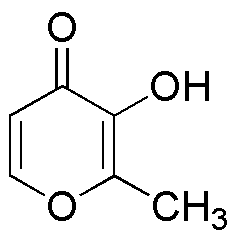Maltol is widely utilized in research focused on
- Flavoring Agent: Commonly used in the food industry, maltol enhances the sweetness and aroma of various products, including baked goods, candies, and beverages, making them more appealing to consumers.
- Fragrance Industry: It serves as a key ingredient in perfumes and cosmetics, providing a sweet, caramel-like scent that can improve the overall fragrance profile of products.
- Pharmaceutical Applications: Maltol is used in the formulation of certain medications to mask unpleasant tastes, improving patient compliance, especially in pediatric formulations.
- Antioxidant Properties: In research, maltol has shown potential as a natural antioxidant, which can be beneficial in food preservation and in developing health supplements aimed at reducing oxidative stress.
- Biochemical Research: Maltol is employed in various biochemical assays and studies, particularly in exploring its effects on metabolism and its role as a chelating agent for metal ions in biological systems.
General Information
Properties
Safety and Regulations
Applications
Maltol is widely utilized in research focused on
- Flavoring Agent: Commonly used in the food industry, maltol enhances the sweetness and aroma of various products, including baked goods, candies, and beverages, making them more appealing to consumers.
- Fragrance Industry: It serves as a key ingredient in perfumes and cosmetics, providing a sweet, caramel-like scent that can improve the overall fragrance profile of products.
- Pharmaceutical Applications: Maltol is used in the formulation of certain medications to mask unpleasant tastes, improving patient compliance, especially in pediatric formulations.
- Antioxidant Properties: In research, maltol has shown potential as a natural antioxidant, which can be beneficial in food preservation and in developing health supplements aimed at reducing oxidative stress.
- Biochemical Research: Maltol is employed in various biochemical assays and studies, particularly in exploring its effects on metabolism and its role as a chelating agent for metal ions in biological systems.
Documents
Safety Data Sheets (SDS)
The SDS provides comprehensive safety information on handling, storage, and disposal of the product.
Product Specification (PS)
The PS provides a comprehensive breakdown of the product’s properties, including chemical composition, physical state, purity, and storage requirements. It also details acceptable quality ranges and the product's intended applications.
Certificates of Analysis (COA)
Search for Certificates of Analysis (COA) by entering the products Lot Number. Lot and Batch Numbers can be found on a product’s label following the words ‘Lot’ or ‘Batch’.
*Catalog Number
*Lot Number
Certificates Of Origin (COO)
This COO confirms the country where the product was manufactured, and also details the materials and components used in it and whether it is derived from natural, synthetic, or other specific sources. This certificate may be required for customs, trade, and regulatory compliance.
*Catalog Number
*Lot Number
Safety Data Sheets (SDS)
The SDS provides comprehensive safety information on handling, storage, and disposal of the product.
DownloadProduct Specification (PS)
The PS provides a comprehensive breakdown of the product’s properties, including chemical composition, physical state, purity, and storage requirements. It also details acceptable quality ranges and the product's intended applications.
DownloadCertificates of Analysis (COA)
Search for Certificates of Analysis (COA) by entering the products Lot Number. Lot and Batch Numbers can be found on a product’s label following the words ‘Lot’ or ‘Batch’.
*Catalog Number
*Lot Number
Certificates Of Origin (COO)
This COO confirms the country where the product was manufactured, and also details the materials and components used in it and whether it is derived from natural, synthetic, or other specific sources. This certificate may be required for customs, trade, and regulatory compliance.


